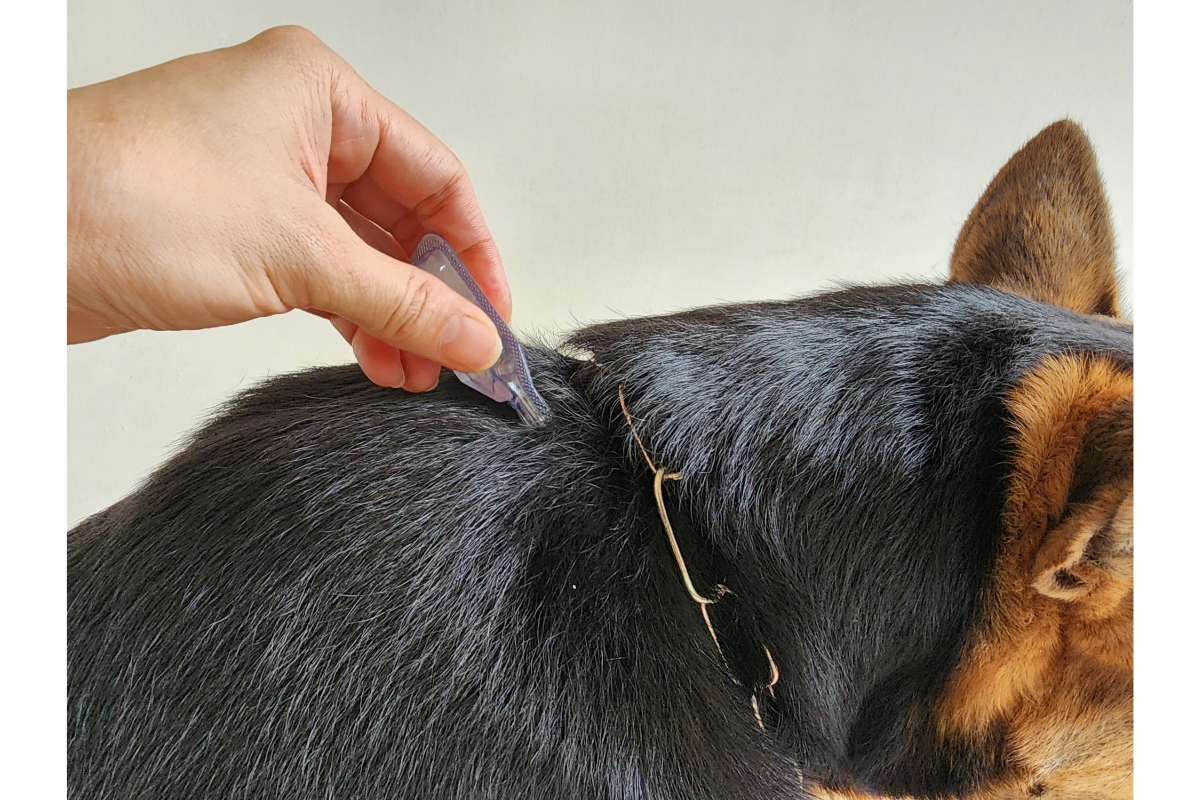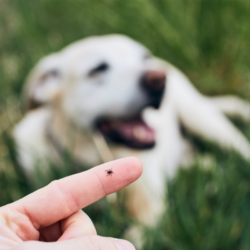Tick-borne encephalitis is an inflammatory viral disease of the brain, transmitted mainly by the bite of infected ticks. This disease, which is often associated with specific geographical regions where ticks are present, presents symptoms that vary in severity, from mild headaches to serious neurological complications.
What is the pathogen?
Central European tick-borne encephalitis, caused by the Tick Born Encephalitis Virus (TBE), is a serious neurological condition. It is spread mainly by the bites of ticks, in particular the Ixodes persulcatus and Ixodes ricinus species, which proliferate in forests stretching from Alsace to the Pacific coast of Asian Russia, and as far north as China. Two variants of the virus exist, one in the east (Russian summer vernal encephalitis virus or Taiga fever) presenting more severe forms of the disease than the one in the west, and reputed to be less sensitive to preventive vaccines.
This flavivirus of the Flaviviridae family has a natural cycle involving ticks of the genus Ixodes and forest micro-mammals such as voles and field mice. Tick-borne encephalitis, also known as tick-borne meningoencephalitis or tick-borne vernal meningoencephalitis (TBE), affects humans and most mammals.
The tick-borne encephalitis virus belongs to the Flavivirus genus, which also includes viruses such as dengue fever, yellow fever and Japanese encephalitis. Its structure comprises an outer envelope carrying two proteins, M and E, which are involved in its identification and immunogenicity. The virus is sensitive to heat and can be destroyed by pasteurisation. However, it can survive in certain environments, making its transmission potentially dangerous.
With nearly ten thousand cases estimated each year worldwide, vigilance remains essential in the face of this viral threat. With its genome encoding a structural polyprotein and seven non-structural proteins, viral replication is a complex process that remains largely unexplored. The production of immature and partially mature virions is interpreted as an immune escape strategy. This underlines the need for ongoing research to better understand and combat this disease.
Focus on ticks
Hard ticks of the genus Ixodes play a central role in the spread of the TBE virus, acting as both vectors and reservoirs of infection. In Eurasia, more than 8 species have been identified as capable of transmitting the virus, including Ixodes ricinus and Ixodes hexagonus in Europe, Ixodes persulcatus in Siberia, and Haemaphysalis concinna in Asia.
The tick’s biological cycle takes place in three stages (larva, nymph, adult) over an average period of one year, although this may vary according to climatic conditions. Ticks prefer to hibernate in damp undergrowth, where the females lay hundreds of potentially infected eggs.
Once hatched, the larvae become active as soon as the temperature rises above 5°C and wait for their potential host, often a small animal such as a mouse or squirrel. During their blood meal, they can transmit the virus to their host or infect themselves if the host is a carrier of the virus. A “co-feeding” phenomenon can also occur, where infected larvae or nymphs transmit the virus to other uninfected larvae or nymphs.
After their meal, the larvae metamorphose into nymphs, then into adults after another blood meal, 1 to 2 years later. Adult ticks, measuring just a few millimetres in length, can climb up to 80 cm to reach a larger animal. After another blood meal, the tick mates, lays eggs and the cycle begins again.
The virus multiplies and spreads throughout the tick’s body, including in the salivary glands, facilitating transmission by bite, and in the ovaries, allowing transovarial transmission from the female to her offspring. Although infected ticks do not develop disease, they remain carriers of the virus throughout their lives.
How does the disease manifest itself in animals?
Central European tick-borne encephalitis affects a variety of animal species, both wild and domestic. These include mammals such as rodents, deer, wild boar and hares, as well as domestic animals such as dogs, cattle, sheep, goats and horses. Domestic or wild birds and even reptiles are not spared. Ticks play a major role as vectors and reservoirs of the virus.
The geographical distribution of cases of infection remains largely unknown, but the virus is mainly transmitted by the bite of a tick of the genus Ixodes. These parasites retain the infection throughout their lives, and females can pass it on to their offspring.
In animals, symptoms are often absent or mild, although some, such as dogs and horses, may show nervous signs. Small rodents, such as the collared field mouse and wood vole, are the main reservoirs of the virus, exhibiting prolonged viremia at high levels. Large mammals and birds also play a role in the spread of the virus, although their viremia is weaker and short-lived.
Unlike other mosquito-borne flaviviruses, humans are not actively involved in the transmission of the TBE virus in its natural cycle. Instead, they are regarded as occasional hosts, although their role is crucial in the ecology of ticks and the spread of the virus.
How is it transmitted?
Transmission of the Central European tick-borne encephalitis virus is mainly ensured by the bite of an infected tick, generally of the species Ixodes ricinus, at all stages of its development. Infected animals or tick carriers generally do not transmit the disease to humans, with the exception of rare cases, notably through the consumption of raw goat’s or sheep’s milk or cheese.
Occupations exposed to the risk of tick bites, such as lumberjacks, foresters and gamekeepers, are particularly at risk. The peak transmission periods for the virus are generally late spring and late summer, with ticks less active during hot, dry summers.
In humans, ticks generally choose thin, moist areas of skin to attach themselves to, such as the umbilicus, armpit or hairline at the nape of the neck. The virus is transmitted mainly by the injection of saliva during the bite, which is often painless thanks to the anaesthetic effect of the tick’s saliva.
In addition to transmission by bite, food transmission is also possible through the consumption of raw milk or unpasteurised dairy products from infected animals. Although human-to-human transmission is theoretically possible, it remains rare.
The prevalence of the virus in ticks varies from region to region, with an increase in the incidence of tick-borne encephalitis probably linked to global warming. Despite the existence of an effective vaccine, its under-use among at-risk groups remains a challenge. In France, vaccination is not generally recommended for residents due to the rarity of the disease, but may be recommended for travellers to forested areas of Central and Eastern Europe during spring and summer.
What are the symptoms of the disease in humans?
Tick-borne encephalitis (TBE) is characterised by symptoms similar to those of summer flu, occurring one to two weeks after the tick bite. Possible complications include impaired balance, consciousness, intellectual or psychological capacity, or even meningitis. Serious neurological sequelae can occur, including disability, nerve disorders such as paralysis, and even fatal complications in 1 to 2% of cases.
There is no specific treatment for TBE. Clinical manifestations, observed in 20-40% of cases, include non-specific flu-like symptoms such as fever, fatigue, headaches, aches and pains, sometimes accompanied by digestive problems. In a third of cases, these symptoms can progress to a more severe form, requiring hospitalisation. The severity of the disease varies according to the viral subtype and the patient’s age.Incubation usually lasts 7 to 14 days (extremes 2 and 28 days) after the tick bite.
Incubation
Free interval
In almost 35% of cases, the patient does not recover spontaneously, marking the start of a critical phase in the infection. Having reached different tissues and organs, the virus then begins a new duplication phase, leading to viral multiplication in the body. This period, which generally lasts a week, is characterised by an asymptomatic remission, when the clinical manifestations of the disease are no longer apparent. However, despite the apparent absence of symptoms, the virus remains active, actively reproducing in infected cells and continuing to spread throughout the body.
Neurological phase
The neurological phase of tick-borne encephalitis (TBE) is characterised by the invasion of the virus into the central nervous system (CNS), leading to an increase in fever compared with the viremic phase. The majority of cases (50%) present as clear-fluid viral meningitis, mainly in children. Around 40% of cases develop meningoencephalitis, with symptoms including pyramidal syndrome, cerebellar syndrome and cranial nerve damage. Half of adult patients develop encephalitis. Around 10% of cases in the neurological phase also manifest as myelitis, with flaccid paralysis of the upper limb. The duration of the disease varies from a few days to several weeks.
In most cases (90%), recovery is complete without sequelae. However, around 1-2% of patients die at this stage, while 10-20% suffer permanent neurological sequelae. A third of patients may present residual disorders several years after the disease, such as headaches, sensory or neurovegetative disorders, constituting a post-encephalitic syndrome.
Deaths due to neurological complications mainly occur in patients aged over 60. The next phase of the disease sees the FSME virus attack the CNS, with symptoms such as headaches, neck pain, difficulty concentrating, impaired consciousness, convulsions and paralysis. Lasting sequelae, present in around one in five patients suffering from meningitis with encephalitis, may include problems with memory, concentration and control of movement. Around 1% of patients with neurological symptoms die from tick-borne meningoencephalitis.
How is tick-borne encephalitis treated?
Diagnosis of tick-borne encephalitis relies mainly on laboratory biological methods, as the clinical signs are not specific. During the initial viremic phase of the disease, clinicians can detect the virus in blood cultures. In the neurological phase, they can isolate the virus from cerebrospinal fluid (CSF). Specialist laboratories culture the virus, a complex procedure that is tending to be replaced by polymerase chain reaction (PCR). Clinicians can look for anti-TBEV antibodies, detectable at the start of the neurological phase, in serum and CSF using the ELISA method. This makes it possible to differentiate between an ongoing infection and one that has gone undetected.
As far as treatment is concerned, there is no specific antiviral treatment for tick-borne encephalitis. Treatment focuses on symptom management, with hospitalisation generally recommended for affected patients, although there is no need for isolation due to the absence of human-to-human transmission. Doctors adapt resuscitation care according to the severity of the symptoms, implementing measures such as the administration of analgesics, antipyretics, vitamins, hydration and electrolytes. In serious cases with complications such as respiratory paralysis, they apply appropriate treatment, such as intubation and assisted ventilation.
Some regions, such as the Russian Federation, continue to practise post-exposure treatment with specific immunoglobulins despite their side effects, which have led to their abandonment in other places. In addition, the use of high-dose corticosteroids is widespread in certain endemic regions, although their effectiveness compared with symptomatic treatment remains debatable according to retrospective studies.
How can you prevent infection?
Preventing tick-borne encephalitis in animals involves rapidly removing ticks. For dogs, we recommend wearing a tick-proof collar or following a preventive acaricide treatment.
For humans, raising awareness and training workers about the risks associated with tick-borne encephalitis are essential. This includes appropriate hygiene and prevention measures, such as the provision of drinking water, soap, single-use wiping materials (such as paper towels), and a first-aid kit including splinter tweezers or tick remover and disinfectant. In addition, work clothing and personal protective equipment must be provided, in good condition, clean and well maintained.
The medical authorities recommend vaccinating those exposed in endemic areas. It is also advisable to wear clothing that covers the arms and legs when in the forest, and to apply a skin repellent regularly and inspect the body carefully after a day’s work outdoors to detect and remove ticks quickly.
There is no vaccine available for animals. However, the use of effective antiparasitic treatments against ticks can limit the risk of infection. It is also advisable to limit animal contact with wooded areas where ticks and the virus are present.
With regard to vaccination against tick-borne meningoencephalitis in humans, several vaccines are available, offering effective protection in most cases. Vaccination schedules vary according to the vaccine used, but all require several doses to ensure optimal protection. The side effects of vaccines are generally minor, but local or general reactions can sometimes occur.
Some epidemiological data…
The TBE virus is found exclusively in Eurasia, in non-tropical forest areas stretching from Alsace-Lorraine to the island of Hokkaidō in Japan. It is unevenly distributed, occurring in scattered foci corresponding to optimal conditions for ticks and their hosts, mainly in and around forests.
The incidence oftick-borne encephalitis is significant in Europe, with around 10,000 cases reported annually in Russia and Europe, with the highest incidences in the former USSR and the Baltic states. Central Europe,Germany,Austria and Switzerland also report significant numbers of cases. In France, although cases are less frequent, their numbers are increasing, particularly in the Alsace-Lorraine departments.
The disease initially affected specific risk groups such as agricultural and forestry workers, hunters and gatherers, but with increasing tourism to forested areas, the majority of infections now occur during outdoor leisure activities. The American and Australian continents are spared from the TBE virus, but a few cases can occur during travel. In Austria and Germany, a significant proportion of the population has specific antibodies, indicating previous exposure to the virus.
A number of factors influence the spread of tick-borne encephalitis, including climate change, which favours tick development, forest and wildlife management practices, and the adaptation of ticks to biocides. The recent increase in cases in France, particularly those associated with the consumption of raw-milk goat’s cheese, highlights the need for enhanced surveillance and prevention measures, including raising public awareness and finding effective treatment and prevention solutions.
ANSES actions
In order to gain a better understanding of the risk of infection for humans, whether through tick bites or food consumption, the work carried out by the ANSES focuses on several crucial areas:
- Epidemiology of tick-borne encephalitis virus (TBEV) in France: this involves studying the transmission cycle, the role of hosts, the distribution of the virus and its determinants, as well as assessing the exposure of ruminants to the virus.
- Virus detection and persistence of the infectious virus in milk and cheese matrices: this part includes the methodological development of virus detection, the isolation and quantification of the infectious virus in different matrices, the identification of dairy products at risk and storage conditions that favour the persistence of infectious viruses.
- Vector competence of the tick in relation to TBEV: this involves identifying the molecular mechanisms that enable the tick to become infected, replicate and transmit the TBEV virus, as well as studying the co-infections of the tick with TBEV and Borrelia.
- Host/pathogen interactions for a better understanding of transmission and the pathology induced, as well as the host specificity of TBEV.
- Development of anti-TBEV antiviral molecules to counter viral infection.
In addition, Anses teams are involved in the investigation of farms suspected of being the source of human cases following the consumption of contaminated unpasteurised products. As a national reference laboratory (NRL), the Anses also carries out investigations to identify the foods responsible for cases of Collective Foodborne Toxi Infection (CFTI).
WHO recommendations
The WHO ‘s recommendations are based on in-depth knowledge of the disease, including surveillance,risk assessment and cost-effectiveness. In countries where the disease is highly endemic, with at least 5 cases per 100,000 inhabitants per year before the introduction of the vaccine, generalised vaccination is recommended. In all endemic areas, it is crucial that information about the disease, its vectors, modes of transmission and preventive measures should be readily available to the public.
In Europe, almost 80 million doses of vaccine have been administered since 1980. European vaccines can only be found in Canada in the Americas, where they are offered as travel vaccines.Austria is the only country to have introduced systematic vaccination against tick-borne encephalitis since 1981, with vaccination coverage reaching 88% of the general population in 2005.
Vaccination recommendations vary according to the epidemiological situation and risk assessment in other European countries, and may change as the situation changes. In Switzerland, vaccination is recommended in all cantons, from the age of 6, except in Geneva and Ticino.





